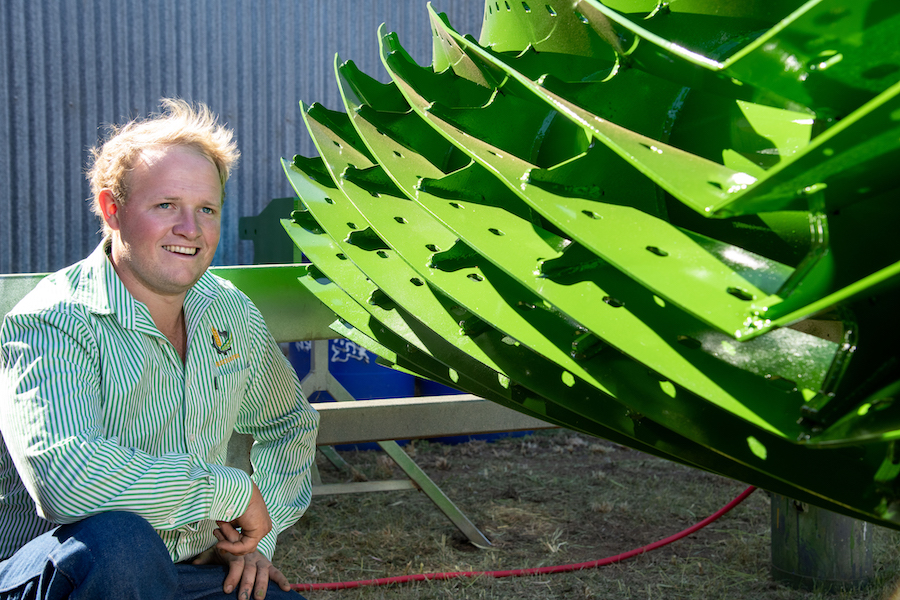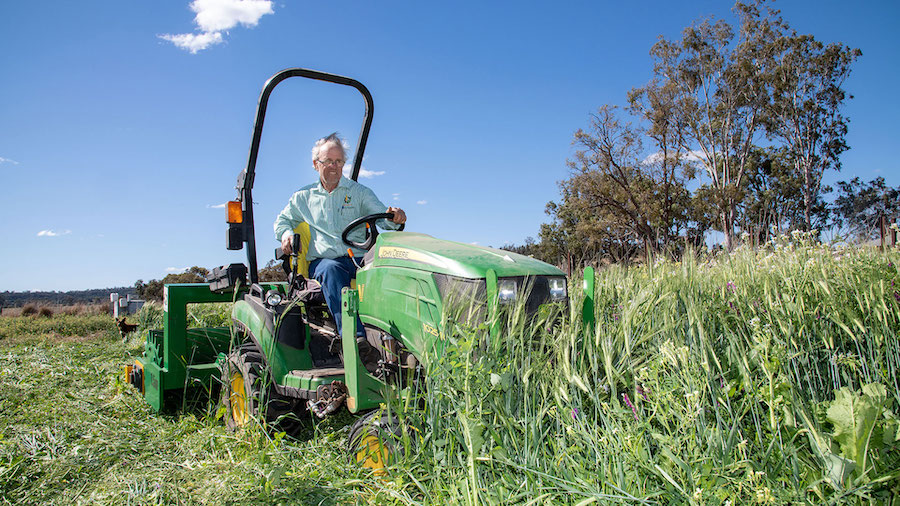Key points
- Charlie Lange built the Auscrimper to terminate cover crops without spraying them
- With his father David, Charlie runs a mixed-farming enterprise on Queensland’s Darling Downs
- Since early last year he has sold more than 20 machines and is looking for larger premises
- Charlie and Amie Lange are participants in a GRDC-supported innovation program.
Last year, Charlie Lange’s phone started ringing a bit more than usual. Grain growers and other agricultural producers were calling, interested in his Auscrimper Cover Crop Roller. The machine terminates a cover crop by rolling it, leaving a layer of mulch, and allowing for a second, cash crop to be planted.
Charlie, a qualified welder, runs an 800-hectare mixed-farming enterprise with his father David on Queensland’s Darling Downs. He had built the original roller about six years ago to terminate cover crops without spraying. However, 2020’s combination of good weather and increasing interest in cover cropping practices had renewed growers’ awareness of his product.
Since then, he has sold 22 rollers, left his off-farm welding job, employed three other welders, and is now looking for larger premises. “I’ve been a bit busy,” he says, adding he also married partner Amie in that time too.
Charlie and Amie Lange are participants in the GRDC Growers as Innovators initiative, run by Farmers2Founders. Through the Bootcamp program, which provides support for those with innovative ideas, Charlie and Amie were keen to learn how to scale-up their manufacturing to meet demand and develop new sales and marketing strategies.
Today, their plans also include website upgrades and undertaking more trials, although this latter goal has been hampered somewhat by COVID-19 and associated lockdowns. “We are also working on new product development, building a planter and roller in one. It will attach to the front of the planter, so you can roll and plant in one pass.”
The crimper
Charlie says the original roller design came about because the family wanted to continue cover cropping but reduce or eliminate the need to spray the crop out. Cover crops are normally terminated at an appropriate time depending on that crop and the next planting.

Charlie Lange with a 2.6m crimper that is headed to a farm in Victoria. Photo: Bev Lacey
“We’d been investigating ideas through the Rodale Institute in the US but couldn’t find Australian machinery to roll the cover crops. I’m a welder so I decided to build something. The first machine was 3.6 metres. We did some trials but then ran into a few years of drought. There was not much of a chance to test it at home, but we had some neighbours who trialled it.”
The Auscrimper works by pushing the crop to the ground, creating a mulch layer. It has chevron-pattern blades, a crimping interval of 110 millimetres, a replaceable axle and the drum can be filled with water to add extra weight.
Charlie says this mulch layer encourages the soil health nutrient cycle, builds and retains soil moisture, feeds and provides a home for soil microbes, and keeps soil temperatures cooler during summer and warmer during winter.
He says more and more growers and producers are interested in cover cropping. “It helps keep soil temperature cool, decreases weeds and there is an increase in soil microbes and soil health.”
He says the benefits of cover cropping are also found in other agricultural industries, with his rollers being purchased by vineyards and macadamia farms. “The first one went to a macadamia farmer from northern NSW. He decided to increase cover cropping and pulled out every second row of macadamia trees to put cover crops down.”
Charlie’s father David has been interested in cover cropping and efficient water and nutrient use for some time, with the Millennium Drought a key turning point.
“The 2000 drought really made Dad rethink things and look for another way to use the rainfall more efficiently. That started a journey that led to time-controlled rotational grazing, cover cropping, pasture cropping and biological inoculants.” David was also an early adopter of no-till farming practices in the 1990s.

David Lange demonstrates crop rollover in a multispecies cover crop using the 1.5m crimper. Photo: Bev Lacey
Currently, a typical rotation may include white French millet, forage sorghum and legumes as cover crops. These are planted in the summer and rolled before planting a winter cereal crop. The family also run 300 head of beef cattle, which graze pasture and the winter stubble.
David adds that improving soil health creates greater profitability in the long run. Although he has always dabbled in ways to do things better, he says he had an “a-ha” moment when driving around the farm with an agronomist years ago.
“We noticed some barnyard grass and I went to pull it out. Despite the paddock being so dry, the soil around the plant was moist. You could roll the dirt in your fingers. Yet just 300mm away there were cracks in the soil 600mm deep and no moisture in the soil where there were no living plants. It was so dry. It made me think about cover crops and how they keep the moisture in and how plants extract moisture from the atmosphere. Our journey started from there.”
GRDC is supporting innovation investment through its Australian Grains Innovation Program. This includes the ‘Growers as Innovators’ and ‘Accelerator’ programs. In 2020-21 the programs were delivered in partnership with Farmers2Founders, SparkLabs Cultiv8 and SproutX and provide support for innovation at different developmental stages. View Agtech innovation initiatives.
More information: Charlie Lange, 0475 205 443, Auscripmer

























































